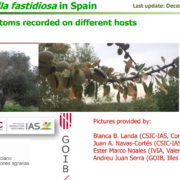Rapid screening tests for differentiating Xylella fastidiosa isolates
Authors: M. Saponari, M. Montes-Borrego, G. D’Attoma, L. De La Fuente, G. Loconsole, B.B. Landa
Type of contribution: Conference Abstract | Oral Presentation
Conference: 22th Congress of the Italian Society of Plant Pathology, 19-22 September 2016, Roma (Italy)
Keywords: HRM, Xylella, Detection, SNuPE
Corresponding author: M. Saponari (CNR-IPSP)
Abstract
The bacterial pathogen Xylella fastidiosa (Xf) is characterized by a wide plant host range and insect vectors, and on the basis of phylogenetic studies it was subdivided into different subspecies. Results from strain typing, phylogenetic analyses, and other data comparisons have shown that phylogenetic clusters exhibit host-based genetic relationships. Until now, different molecular tests can be used for the differentiation of Xf isolates, among which MLST/MLSA represents the most common method to determine classification and phylogenetic placement of novel isolates. Xf outbreaks in EU motivated the search for accurate and faster approaches for detection and identification of the bacterium in different plant matrices. Because MLST/MLSA requires several PCR reactions and sequencing analyses, we have developed two independent approaches for rapid taxonomic assignment of uncharacterized isolates: (1) single-nucleotide primer extension (SNuPE) method for the multiplex amplification of six Xylella DNA sequences (targeting all subspecies and three genotypes within Xf subsp. pauca including the type-isolate infecting olive in Italy); (2) high-resolution melting analysis of the amplicon recovered from the gene encoding the conserved HL protein. Both assays proved to clearly differentiate Xf isolates currently known to occur in the Italian and France outbreaks. Indeed, validation on a larger panel of isolates covering the different subspecies consistently allowed to rapidly differentiate the isolates in different clusters. In conclusion, these approaches represent a useful tool for pre-screening and selection of infected samples to be further analyzed by MLST or whole genome sequencing.







